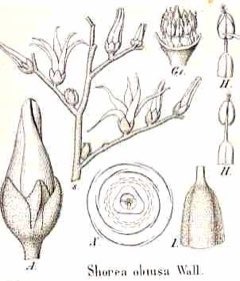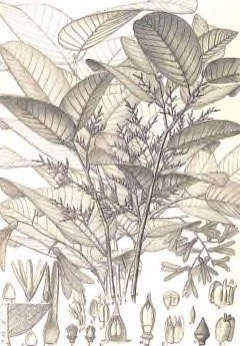 |
|
http://www.edibleplants.org |
 |
| http://www.edibleplants.org |
Translate this page:
Summary
Found in Thailand, Myanmar, Cambodia, Laos, and Vietnam, Shorea obtusa is a deciduous tropical tree growing in relatively dry areas, reaching a height of about 10- 30 m and bole diameter of up to 60 cm. The flowers are yellow that droop in clusters. The plant yields a very hard timber, which is used for construction purposes, with high commercial value. The trunk also yields resin for local and medicinal uses. In particular, it is used in the treatment of wounds, ulcers, dysentery, etc. The resin is also used for caulking boats and baskets, and in making traditional torches.
Physical Characteristics

 Shorea obtusa is a deciduous Tree growing to 20 m (65ft) by 15 m (49ft) at a medium rate.
Shorea obtusa is a deciduous Tree growing to 20 m (65ft) by 15 m (49ft) at a medium rate.
See above for USDA hardiness. It is hardy to UK zone 10.
Suitable for: light (sandy) and medium (loamy) soils, prefers well-drained soil and can grow in nutritionally poor soil. Suitable pH: mildly acid and neutral soils and can grow in very acid soils.
It cannot grow in the shade. It prefers dry or moist soil.
UK Hardiness Map
US Hardiness Map
Synonyms
This name is unresolved.
Plant Habitats
Edible Uses
References More on Edible Uses
Medicinal Uses
Plants For A Future can not take any responsibility for any adverse effects from the use of plants. Always seek advice from a professional before using a plant medicinally.
Antibiotic Dysentery Malaria
A resin obtained from the tree is antibiotic. It is used in the treatment of wounds, ulcers etc[404 , 730 ]. It is also recommended as a cure for dysentery[404 ]. The bark is used to treat malaria[404 ].
References More on Medicinal Uses
The Bookshop: Edible Plant Books
Our Latest books on Perennial Plants For Food Forests and Permaculture Gardens in paperback or digital formats.

Edible Tropical Plants
Food Forest Plants for Hotter Conditions: 250+ Plants For Tropical Food Forests & Permaculture Gardens.
More

Edible Temperate Plants
Plants for Your Food Forest: 500 Plants for Temperate Food Forests & Permaculture Gardens.
More

More Books
PFAF have eight books available in paperback and digital formats. Browse the shop for more information.
Shop Now
Other Uses
Furniture Lighting Resin Waterproofing Wood
Other Uses: The bark has a high tannin content[404 ]. A yellowish resin exudes from the bark. It is used for caulking baskets and boats and to make a traditional torch[404 , 730 ]. The heartwood is brown, turning to dark brown or dark reddish brown, often with fine dark lines; the narrow band of sapwood is pale yellow to pale brownish-white. Texture is medium, the grain interlocked and lustre is dull. The wood is heavy, very hard and durable, especially in the open and in contact with water. Sawing is reported to be rather difficult, mostly due to the high resin content; the wood works quite smooth; it is slightly susceptible to surface cracking and end splitting. However, untreated sleepers have lasted for 15 years[404 ]. The wood is used for construction works, bridges, piles, ship-building, framing of boats, utility and garden furniture, interior uses such as parquet flooring, heavy-duty flooring, window- and door frames. It is also very valuable for railway sleepers[404 ].
Special Uses
References More on Other Uses
Cultivation details
A plant of tropical monsoon climates, where it grows at an elevation up to 1,000 metres. It grows best in areas with a mean annual precipitation of 1,250 - 2,000mm, with a well pronounced wet season and a dry season of up to 6 months. However, it can also grow with less than 1,250mm[404 ]. Requires a sunny position[404 ]. It grows well on well-drained sandy soils, rocky soils, lateritic soils, including ferric acrisols, gleyic acrisols, and ferralic cambisols. Unlike the majority of dipterocarps, it can survive even on very poor soils and rocky areas[404 ]. An acid to neutral pH is suitable[404 ]. In Cambodia it is often found on gray soil on shale[404 ]. The plant is adapted to growing in areas where fires are common in the dry season[404 ].
References Carbon Farming Information and Carbon Sequestration Information
Temperature Converter
Type a value in the Celsius field to convert the value to Fahrenheit:
Fahrenheit:
The PFAF Bookshop
Plants For A Future have a number of books available in paperback and digital form. Book titles include Edible Plants, Edible Perennials, Edible Trees,Edible Shrubs, Woodland Gardening, and Temperate Food Forest Plants. Our new book is Food Forest Plants For Hotter Conditions (Tropical and Sub-Tropical).
Shop Now
Plant Propagation
Seed. The viability of freshly collected seeds is low and after screening out those attacked by insects and clipping the wings, they are sown right away into shaded nursery beds. Survival percentage has been reported to be 65 - 75%[404 ].
Other Names
If available other names are mentioned here
Taengwood Balau, teng, ngae, chik, pra-choek, thitya, phchok, chaf.
Native Range
TROPICAL ASIA: Cambodia, Laos, Myanmar, Thailand, Vietnam
Weed Potential
Right plant wrong place. We are currently updating this section.
Please note that a plant may be invasive in one area but may not in your area so it's worth checking.
Conservation Status
IUCN Red List of Threatened Plants Status : Status: Lower Risk/least concern

Growth: S = slow M = medium F = fast. Soil: L = light (sandy) M = medium H = heavy (clay). pH: A = acid N = neutral B = basic (alkaline). Shade: F = full shade S = semi-shade N = no shade. Moisture: D = dry M = Moist We = wet Wa = water.
Now available:
Food Forest Plants for Mediterranean Conditions
350+ Perennial Plants For Mediterranean and Drier Food Forests and Permaculture Gardens.
[Paperback and eBook]
This is the third in Plants For A Future's series of plant guides for food forests tailored to
specific climate zones. Following volumes on temperate and tropical ecosystems, this book focuses
on species suited to Mediterranean conditions—regions with hot, dry summers and cool, wet winters,
often facing the added challenge of climate change.
Read More
Expert comment
Author
Wall. ex Blume
Botanical References
Links / References
For a list of references used on this page please go here
A special thanks to Ken Fern for some of the information used on this page.
Readers comment
| Add a comment |
|
If you have important information about this plant that may help other users please add a comment or link below. Only comments or links that are felt to be directly relevant to a plant will be included. If you think a comment/link or information contained on this page is inaccurate or misleading we would welcome your feedback at [email protected]. If you have questions about a plant please use the Forum on this website as we do not have the resources to answer questions ourselves.
* Please note: the comments by website users are not necessarily those held by PFAF and may give misleading or inaccurate information.
To leave a comment please Register or login here All comments need to be approved so will not appear immediately.
|
|